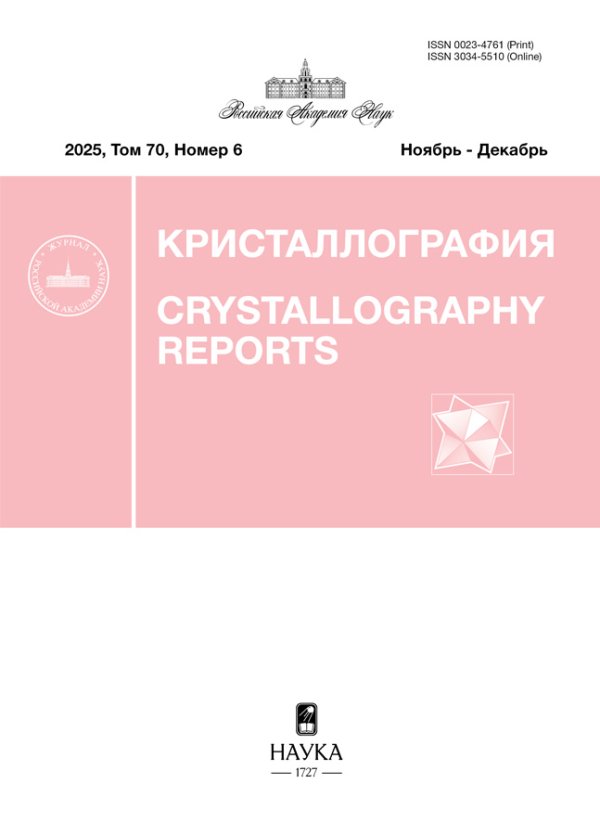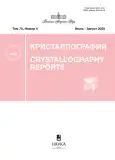Interaction of ferroelectric domain walls and shape of equilibrium repolarization nuclei
- Authors: Belov A.Y.1
-
Affiliations:
- Shubnikov Institute of Crystallography of the Kurchatov Complex Crystallography and Photonics of the NRC “Kurchatov Institute”
- Issue: Vol 70, No 4 (2025)
- Pages: 577-582
- Section: REAL STRUCTURE OF CRYSTALS
- URL: https://journal-vniispk.ru/0023-4761/article/view/306265
- DOI: https://doi.org/10.31857/S0023476125040055
- EDN: https://elibrary.ru/jfpzus
- ID: 306265
Cite item
Abstract
The growth of a repolarization nucleus in an electric field is hindered by cohesive forces acting near its tips on the adjacent domain walls. They can reach large values when the distance between the domain walls becomes comparable to their thickness. It is shown that the cohesive forces are expressed in terms of the coefficients of the Ginzburg–Landau energy expansion, which includes a gradient contribution. For a uniaxial ferroelectric, an estimate of the maximum value of the internal field associated with the gradient interaction of the domain walls is obtained. Its relation to the internal coercive field Ec0 in the Ginzburg–Landau theory is E* max/Ec0 = 3√3/8 ≈ 0.65.
About the authors
A. Y. Belov
Shubnikov Institute of Crystallography of the Kurchatov Complex Crystallography and Photonics of the NRC “Kurchatov Institute”
Author for correspondence.
Email: belov@crys.ras.ru
Russian Federation, Moscow, 119333
References
- Инденбом В.Л. // Изв. AH CCCP. Сep. физ. 1979. Т. 43. С. 1631.
- Инденбом В.Л., Чамров В.А. // Кристаллография. 1980. Т. 25. С. 213.
- Chen I.W., Wang Y. // Appl. Phys. Lett. 1999. V. 75. P. 4186. https://doi.org/10.1063/1.125577
- Chen I.W., Wang I. // Ferroelectrics. 1998. V. 206. P. 245. https://doi.org/10.1080/00150199808009162
- Belov A.Yu., Kreher W.S., Nicolai M. // Ferroelectrics. 2009. V. 391. P. 42. https://doi.org/10.1080/00150190903001128
- Belov A.Yu., Kreher W.S. // Ferroelectrics. 2009. V. 391. P. 12. https://doi.org/10.1080/00150190903001052
- Belov A.Yu., Kreher W.S. // Ferroelectrics. 2007. V. 351. P. 79. https://doi.org/10.1080/00150190701353093
- Viola G., Chong K.B., Guiu F., Reece M.J. // J. Appl. Phys. 2014. V. 115. P. 034106. https://doi.org/10.1063/1.4856235
- Du X., Chen I.W. // Mater. Res. Soc. Symp. Proc. 1998. V. 493. P. 311. https://doi.org/10.1557/PROC-493-311
- Nam S.M., Kil Y.B., Wada S., Tsurumi T. // Jpn. J. Appl. Phys. 2003. V. 42. № 12B. P. L1519. https://doi.org/10.1143/JJAP.42.L1519
- Tsurumi T., Num S.M., Kil Y.B., Wada S. // Ferroelectrics. 2001. V. 259. P. 43. https://doi.org/10.1080/00150190108008714
- Lawless W.N. // Phys. Rev. B. 1978. V. 17. P. 1458. https://doi.org/10.1103/PhysRevB.17.1458
- Jung D.J., Dawber M., Scott J.F. et al. // Integr. Ferroelectr. 2002. V. 48. P. 59. https://doi.org/10.1080/10584580215437
- Mulaosmanovic H., Ocker J., Müller S. et al. // ACS Appl. Mater. Interfaces. 2017. V. 9. P. 3792. https://doi.org/10.1021/acsami.6b13866
- Borowiak A.S., Garcia-Sanchez A., Mercone S. // 2016 Joint IEEE International Symposium on the Applications of Ferroelectrics, European Conference on Application of Polar Dielectrics, and Piezoelectric Force Microscopy Workshop (ISAF/ECAPD/PFM). IEEE. New York, 2016. P. 1. https://doi.org/10.1109/ISAF.2016.7578088
- Белов А.Ю. // Письма в ЖЭТФ. 2018. Т. 108. С. 225.
- Landauer R. // J. Appl. Phys. 1957. V. 28. P. 227. https://doi.org/10.1063/1.1722712
- Tagantsev A.K., Stolichnov I., Setter N. // Phys. Rev. B. 2002. V. 66. P. 214109. https://doi.org/10.1103/PhysRevB.66.214109
- Belov A.Yu. // Ferroelectrics. 2019. V. 544. P. 27. https://doi.org/10.1080/00150193.2019.1598180
- Belov A.Yu. // Ferroelectrics. 2022. V. 590. P. 19. https://doi.org/10.1080/00150193.2022.2037935
- Belov A.Yu. // Mater. Phys. Mech. 2024. V. 52. P. 18. https://doi.org/10.18149/MPM.5212024_2
- Belov A.Yu. // Ferroelectrics. 2025. V. 619. P. 25. https://doi.org/10.1080/00150193.2024.2327956
- Barenblatt G.I. // Adv. Appl. Mech. 1962. V. 7. P. 55. https://doi.org/10.1016/S0065-2156(08)70121-2
Supplementary files










